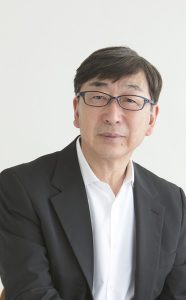ARCHITECTURE: Toyo Ito
Toyo Ito (1/6/1941- ) is a Japanese architect known for creating conceptual architecture, in which he seeks to simultaneously express the physical and virtual worlds. He is a leading exponent of architecture that addresses the contemporary notion of a “simulated” city, and has been called “one of the world’s most innovative and influential architects.” In 2013, Ito was awarded the Pritzker Prize. He was a likely front-runner for the Pritzker Prize for the previous 10 years.
By Efi Michalarou
 Toyo Ito was born in Seoul, Korea in 1941. In 1943, he moved to Japan with his mother and two sisters, and graduated from the University of Tokyo’s department of architecture in 1965. After working for Kiyonori Kikutake Architect and Associates from 1965 to 1969 (alongside Itsuko Hasegawa), in 1971 he started his own studio in Tokyo, named Urbot (“Urban Robot”). In 1979, the studio name was changed to Toyo Ito & Associates. Throughout his early career Ito constructed numerous private house projects that expressed aspects of urban life in Japan. His most remarkable early conceptual contributions were made through projects of this scale, such as White U (1976) and Silver Hut (1984). With the Pao for the Tokyo Nomad Girl projects in 1985 and 1989, Ito presented a vision of the life of an urban nomad, illustrative of typical lifestyles during the bubble economy period in Japan. Tower of Winds (1986) and Egg of Winds (1991) are interactive landmarks in public spaces, resulting from a creative interpretation of contemporary technical possibilities. Whilst their function is in fact exhaust air outlets for the underground system below, their significance lies in Ito’s treatment of their opacity, one of the hallmarks of his work. Whilst appearing solid during the day, the perforated aluminium structures “dissolve” at night through the use of computer-controlled light systems which form an interactive display representing measured data such as noise levels in their surrounding vicinity. Toyo Ito’s office is known as a training ground for talented younger architects. Architects who previously worked for his office include Kazuyo Sejima and Ryue Nishizawa (SANAA), Astrid Klein and Mark Dytham (KDa), Katsuya Fukushima, Makoto Yokomizo, and Akihisa Hirata. Ito’s work is often said to have affinities with the ideas of philosophers such as Munesuke Mita and Gilles Deleuze. Ito has defined architecture as “clothing” for urban dwellers, particularly in the contemporary Japanese metropolis. This theme revolves around the equilibrium between the private life and the metropolitan, “public” life of an individual. The current architecture of Toyo Ito expands on his work produced during the postmodern period, aggressively exploring the potentials of new forms. In doing so, he seeks to find new spatial conditions that manifest the philosophy of borderless beings.
Toyo Ito was born in Seoul, Korea in 1941. In 1943, he moved to Japan with his mother and two sisters, and graduated from the University of Tokyo’s department of architecture in 1965. After working for Kiyonori Kikutake Architect and Associates from 1965 to 1969 (alongside Itsuko Hasegawa), in 1971 he started his own studio in Tokyo, named Urbot (“Urban Robot”). In 1979, the studio name was changed to Toyo Ito & Associates. Throughout his early career Ito constructed numerous private house projects that expressed aspects of urban life in Japan. His most remarkable early conceptual contributions were made through projects of this scale, such as White U (1976) and Silver Hut (1984). With the Pao for the Tokyo Nomad Girl projects in 1985 and 1989, Ito presented a vision of the life of an urban nomad, illustrative of typical lifestyles during the bubble economy period in Japan. Tower of Winds (1986) and Egg of Winds (1991) are interactive landmarks in public spaces, resulting from a creative interpretation of contemporary technical possibilities. Whilst their function is in fact exhaust air outlets for the underground system below, their significance lies in Ito’s treatment of their opacity, one of the hallmarks of his work. Whilst appearing solid during the day, the perforated aluminium structures “dissolve” at night through the use of computer-controlled light systems which form an interactive display representing measured data such as noise levels in their surrounding vicinity. Toyo Ito’s office is known as a training ground for talented younger architects. Architects who previously worked for his office include Kazuyo Sejima and Ryue Nishizawa (SANAA), Astrid Klein and Mark Dytham (KDa), Katsuya Fukushima, Makoto Yokomizo, and Akihisa Hirata. Ito’s work is often said to have affinities with the ideas of philosophers such as Munesuke Mita and Gilles Deleuze. Ito has defined architecture as “clothing” for urban dwellers, particularly in the contemporary Japanese metropolis. This theme revolves around the equilibrium between the private life and the metropolitan, “public” life of an individual. The current architecture of Toyo Ito expands on his work produced during the postmodern period, aggressively exploring the potentials of new forms. In doing so, he seeks to find new spatial conditions that manifest the philosophy of borderless beings.
















